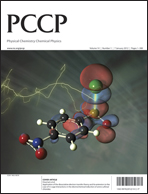Identifying Winner-Takes-All Emergence in Random Nanowire Networks: an Inverse Problem
IF 2.9
3区 化学
Q3 CHEMISTRY, PHYSICAL
引用次数: 0
Abstract
Random nanowire networks (NWNs) are interconnects that enable the integration of nanoscopic building blocks (the nanowires) in a disorganized fashion, enabling the study of complex emergent phenomena in nanomaterials and built-in fault-tolerant processing functionalities; the latter can lead to advances in large-scale electronic devices that can be fabricated with no particular array/grid high-precision pattern. However, when various nanowires are assembled to form an intricate network, their individual features are somehow lost in the complex NWN frame, in line with the complexity hallmark “the whole differs from the sum of the parts”. Individual nanowire materials and geometrical features can only be inferred indirectly by attempting to extract information about their initial conditions from a response function measurement. In this work, we present a mathematical framework that enables inference of the intrinsic properties of highly complex/intricate systems such as random NWNs in which information about their individual parts cannot be easily accessed due to their network formation and dynamical conductance behaviour falling in the category of memristive systems. Our method, named misfit minimization, is rooted in nonlinear regression supervised learning approaches in which we find the optimum parameters that minimize a cost function defined as the square least error between conductance evolution curves taken for a target NWN system and multiple configurational NWN samples composing the training set. The optimized parameters are features referent to the target NWN system’s initial conditions obtained in an inverse fashion: from the response output function, we extract information about the target system’s initial conditions. Accessing the nanowire individual features in a NWN frame, as our methodology allows, enables us to predict the conduction mechanisms of the NWN subjected to a current input source; these can be via a “winner takes all” energy-efficient scheme using a single conduction pathway composed of multiple nanowires connected in series or via multiple parallel conduction pathways. Predicting the conduction mechanism of complex and dynamical systems such as memristive NWNs is critical for their use in next-generation memory and brain-inspired technologies since their memory capability relies on the creation of such pathways activated and consolidated by the input current signal.识别随机纳米线网络中的 "赢家通吃 "现象:一个逆问题
随机纳米线网络(NWN)是一种能够将纳米构件(纳米线)以无序的方式集成在一起的互连器件,可用于研究纳米材料中的复杂突发现象,并具有内置容错处理功能;后者可推动大规模电子器件的发展,这些器件可在没有特定阵列/网格高精度模式的情况下制造。然而,当各种纳米线组装成错综复杂的网络时,它们各自的特征会在复杂的纳米线网络框架中消失,这符合 "整体与部分之和不同 "的复杂性特征。只有尝试从响应函数测量中提取有关其初始条件的信息,才能间接推断出单个纳米线材料和几何特征。在这项工作中,我们提出了一个数学框架,可以推断随机纳米线等高度复杂/错综复杂系统的内在特性,由于它们的网络形成和动态传导行为属于记忆系统的范畴,因此不容易获取其单个部分的信息。我们的方法被命名为误差最小化,它植根于非线性回归监督学习方法,在这种方法中,我们找到最优参数,使成本函数最小化,该成本函数被定义为目标 NWN 系统的电导演化曲线与构成训练集的多个概括性 NWN 样本之间的平方最小误差。优化参数是以反向方式获得的与目标 NWN 系统初始条件相关的特征:我们从响应输出函数中提取目标系统初始条件的信息。在我们的方法论允许的情况下,通过访问氮化网络框架中的纳米线单个特征,我们可以预测氮化网络在电流输入源作用下的传导机制;这些机制可以是通过 "赢家通吃 "的节能方案,使用由多个串联纳米线组成的单个传导通路,也可以是通过多个并联传导通路。预测复杂动态系统(如记忆性 NWN)的传导机制对于它们在下一代记忆和脑启发技术中的应用至关重要,因为它们的记忆能力依赖于创建由输入电流信号激活和巩固的此类通路。
本文章由计算机程序翻译,如有差异,请以英文原文为准。
求助全文
约1分钟内获得全文
求助全文
来源期刊

Physical Chemistry Chemical Physics
化学-物理:原子、分子和化学物理
CiteScore
5.50
自引率
9.10%
发文量
2675
审稿时长
2.0 months
期刊介绍:
Physical Chemistry Chemical Physics (PCCP) is an international journal co-owned by 19 physical chemistry and physics societies from around the world. This journal publishes original, cutting-edge research in physical chemistry, chemical physics and biophysical chemistry. To be suitable for publication in PCCP, articles must include significant innovation and/or insight into physical chemistry; this is the most important criterion that reviewers and Editors will judge against when evaluating submissions.
The journal has a broad scope and welcomes contributions spanning experiment, theory, computation and data science. Topical coverage includes spectroscopy, dynamics, kinetics, statistical mechanics, thermodynamics, electrochemistry, catalysis, surface science, quantum mechanics, quantum computing and machine learning. Interdisciplinary research areas such as polymers and soft matter, materials, nanoscience, energy, surfaces/interfaces, and biophysical chemistry are welcomed if they demonstrate significant innovation and/or insight into physical chemistry. Joined experimental/theoretical studies are particularly appreciated when complementary and based on up-to-date approaches.
 求助内容:
求助内容: 应助结果提醒方式:
应助结果提醒方式:


